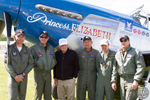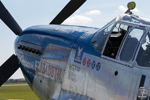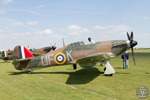 |
The Spring Air Show at The Imperial War Museum Duxford took place on the 26th May 2013 and in part celebrated the 70th anniversary of the American air forces arriving at RAF Duxford during the Second World War. In a continuation of those celebrations on the 27th May 2013 The Eagle Squadron took an aerial tour of East Anglia overflying some of the regions more significant airfields associated with the American Air Forces both past and present. One of the formation aircraft carried a very special guest to these shores a triple ace from the Second World War Colonel Clarence ‘Bud’ Anderson.
The Eagle Squadron aircraft involved were:
P-51C Mustang |
P-47G Thunderbolt |
Spitfire MkIa AR213 |
Hurricane X AE977 |
Paint Schemes & Markings
P-51C MustangPainted to commemorate 42-106449 Princess Elizabeth (but displaying the airframe’s own code 43-25147 on the tail), the Mustang of 1st Lt William T Whisner who flew with the 487th FS, 352nd FG, as it appeared at the time of the D-Day invasion of France complete with D-Day stripes. The aircraft wears the blue nose of this Squadron, nicknamed ‘the Blue Nosed Bastards of Bodney’. It carries squadron coding ‘HO’ to represent the 487th, and the individual aircraft letter ‘W’ sits on the tail.
The original Princess Elizabeth only wore her D-Day stripes for one day, as the aircraft was shot down by ground fire on 6 June 1944 over France. Another pilot, Lt Robert Butler, was flying her that day. He parachuted safely behind Allied lines and soon returned to duty, but the aircraft was lost.
P-47G Thunderbolt
G-CDVX is painted as SNAFU, the mount of 1st Lt Severino B Calderon of the 84th FS, 78th FG. Coded WZ-D, it carries the checkerboard nose markings used to identify the 78th FG and the writing SNAFU, alongside the artwork of War Eagle (the name & art applied by the previous pilot).
Spitfire MkIa AR213
AR213 has received a new paint scheme for the Eagle Squadron display, to represent the mount of Pilot Officer William R Dunn.
AR213 is coded XR-D for No. 71 (Eagle) Squadron, North Weald – XR the squadron code, and the D for Dunn! The paint scheme is the 1941 RAF day scheme. Usually the spinner and identity band would be painted sky color, but the Eagle Squadrons painted theirs white for ease of identification.
Hurricane X AE977
Especially for the Eagle Squadron display, AE977 has received a temporary paint scheme transforming it into P3886 with coding UF-K, a Hurricane of No. 601 (County of London) Squadron. Americans Billy Fiske and Carl Davis both flew P3886, with Carl Davis using the aircraft to destroy 2 JU-87s on 18 August 1940.
Also involved with the tour were:
B-17 Flying Fortress |
P-51 Mustang |
The Eagle Squadron & Colonel Clarence ‘Bud’ Anderson
P-51 Mustang 'Miss Velma' had a very special passenger in the shape of United States Army Air Forces veteran Clarence ‘Bud’ Anderson.'Bud' Anderson is a triple ace having scored a confirmed 16¼ aerial victories. He flew two tours of combat against the Luftwaffe in Europe while with the 363rd Fighter Squadron of the 357th Fighter Group, based at RAF Leiston, England
 |
 |
 |
 |
 |
 |
 |
 |
 |
THE ROUTE
The formation took off shortly before 1200 and formed up for a single pass over Duxford departing the area to follow the route below. The details of this route were provided by Eagle Squadron Ops and may well have altered on the day.
 |
The Eagle Squadron flew over Cambridge American Cemetery at 1200. Home to the UK’s only American WWII cemetery, the site near the village of Madingley provides a final resting place to more than 3,800 war dead, with a further 5,126 names listed on the ‘Tablets of the Missing’. For this section of the flypast, the Eagle Squadron will be joined by B-17 Sally B. For more information visit:
Cambridge American CemeteryRAF MILDENHALL
Home to the modern day "Bloody Hundredth", 100ARW who currently fly the KC-135R the only permanently based USAF air to air refuelling squadron in Europe.
BODNEY – USAAF STATION 141
Situated in Norfolk, Bodney was established as an RAF base in 1940. The USAAF took over the field in May 1943 and laid steel PSP matting over the grass runway. It became home to the 352nd FG Mustangs. Other than the derelict control tower and a memorial, little evidence of Bodney’s past remains.
HALESWORTH – USAAF STATION 365
Purpose built in 1942, this Suffolk airfield was still under construction when the 56th FG’s Thunderbolts arrived in July 1943. Just a few miles from the coast, it later provided an ideal site for the 5th Emergency Rescue Squadron to pick up downed airmen from the North Sea in OA-10A Catalinas, warweary P-47s and specially adapted SB-17s. Halesworth’s concrete runways were torn up recently, but an active airfield museum & memorial remain. For more information visit:
Halesworth Airfield MuseumLEISTON – USAAF STATION 373
Just a few miles from Halesworth, RAF Leiston was allocated to the USAAF in 1942. Initially home to the 358th FG’s P-‐47s, it later hosted the 357th & their P‐51s. Col Bud Anderson flew his Mustang ‘Old Crow’ from Leiston and is looking forward to catching sight of his old base from the air once more. Returned to agriculture post-‐war, some concrete remnants survive including two hard stands (one of which was Colonel Bud’s!) that now house a caravan park. Visitors can pay respects at a nearby memorial, looked after by the Friends of Leiston Airfield. For more information visit:
Leiston AirfieldDEBDEN – USAAF STATION 156
RAF Debden in North Essex was activated in 1937. Hard runways were laid in 1940 and the airfield was central to Battle of Britain ops, as an 11 Group sector airfield. From May 1941 to September 1942 Debden hosted the American pilots of No’s 71, 121 and 133 Eagle Squadrons. On 22 September the Eagle Squadrons were formally handed over to the USAAF, becoming the 334th, 335th and 336th FSs of the 4th FG and the first official American Squadrons on British soil. Debden is currently home to Army bomb disposal experts, the 33rd & 101st Engineer Regiments. Thanks to its military residents, the site is well preserved with many original buildings and intact runways. For more information visit:
RAF DebdenNORTH WEALD
Built during WWI, North Weald was an important station during the Battle of Britain. It also housed two of the three American Eagle Squadrons in the early war years, including Bill Dunn’s No. 71 (Eagle) Squadron. It remained in RAF hands throughout the conflict. Some of the original hangars remain standing, as does the Officer’s Mess. There is a small memorial and an airfield museum. For more information visit:
North Weald MuseumDUXFORD – USAAF STATION 357 (DX)
Located south of Cambridge, and dating back to 1918, Duxford is the best preserved airfield on the route due to its occupancy by the IWM in the late 1970s. Proving itself pivotal in the latter half of the Battle of Britain, Duxford was handed over to the 78th FG in April 1943. Home to three of the Eagle Squadron aircraft, IWM Duxford hosts the UK’s premier collection of vintage aircraft and will be the final destination on the flypast route. The fighters will arrive at 1331 and will finish the flight with an aerial display. For more information visit:
Imperial War Museum DuxfordA big thank you must go out to all those involved with making this article possible in particular Rachel Morris (Eagle Ops) for providing the background information and to Esther Blaine of the IWM for arranging the access to The Eagle Squadron.
